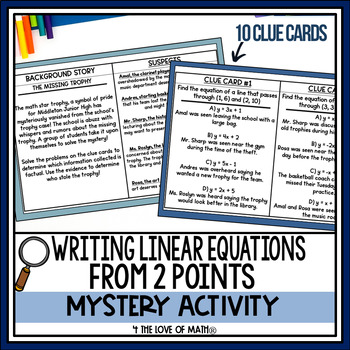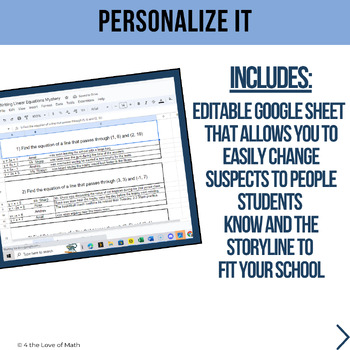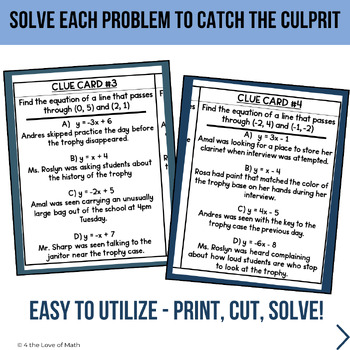Writing Linear Equations from 2 Points Mystery Activity
Description
Engage students in an adventure of problem-solving with this Writing Linear Equations from 2 Points mystery activity! The math trophy has been taken! Who could have done it? Students must write linear equations to determine who the culprit is. With 10 problem questions, students will embark on a journey of eliminating suspects and unveiling the truth!
This writing linear equations from 2 points activity is designed to transform the learning experience into an investigative game, igniting the spirit of curiosity and determination in every student.
This Writing Linear Equations Activity includes:
- 1 Mystery Card: Setting the scene with a detailed scenario (can be edited)
- 5 Suspect Profiles: Dive deep into the mystery with a list of suspects, each with a potential motive and background information (can be edited)
- 10 Engaging Clue Cards: Each card leads students towards finding the guilty culprit featuring writing linear equation questions linked to potential clues.
- Editable Google Sheet: Tailor the experience to your students and school, bringing the mystery to life with familiar faces and settings. Detailed instructions on how to utilize this sheet are included.
- Comprehensive Student Materials: Recording sheets for answer tracking, a mystery page for final accusations, and an answer key for easy facilitation.
Ideas for Implementation of this activity:
- Collaborative Small Groups: Foster teamwork and discussion by having students work in small groups, solving equations and piecing the mystery together.
- Whole Class Engagement: Transform your classroom into a bustling hub of activity, with students moving, discussing, and solving as a united class.
- Interactive Review Sessions: Utilize this activity as a dynamic and enjoyable review session, ensuring readiness for assignments on writing linear equations.
- Self-Correcting Multiple Choice: Each problem comes with four potential answers, empowering students to self-correct and persist in their quest for the right solution.
- Promotes Interaction: The clue cards are designed to be placed around the classroom, turning the lesson into a treasure hunt while fostering collaboration, critical thinking, and lively discussions.
Check out these other "Mystery" Adventures:
Pythagorean Theorem Word Problems
Solving Multi-Step Equations with Variables on Both Sides
Simple Prep:
Print and Go: Preparation is a breeze – simply print the necessary pages, cut the clue cards, hang them around, and you’re ready to dive into the mystery!
Personalize the Experience: Use the editable Google Sheet to introduce familiar faces as suspects, making the mystery irresistibly engaging and fun. Could the culprit be the drama teacher, the basketball coach, or perhaps the principal? You get to choose!





